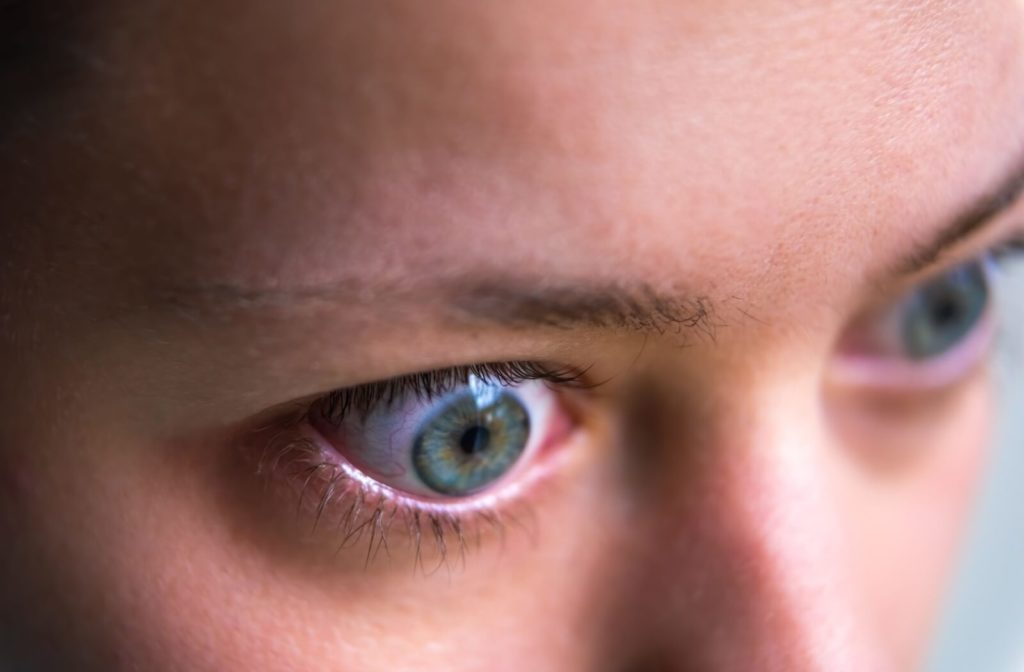Imagine waking up one morning and noticing that your eyes appear to bulge out uncomfortably. It’s unsettling, and as you contact your optometrist, you might wonder if it’s just a temporary issue or something more serious. This scenario is a reality for many individuals living with Graves’ eye disease.
Graves’ eye disease is an autoimmune disorder related to the thyroid that primarily impacts the eyes, leading to symptoms like bulging eyes, double vision, and irritation. Understanding the intricacies of our health can often feel overwhelming, especially when it comes to the eyes—a window to our world and well-being. But a little learning can go a long way, and your optometrist is here to help with an eye exam!
Introduction to Graves’ Eye Disease
Graves’ Eye Disease, also known as thyroid eye disease, is an autoimmune condition associated with an overactive thyroid. It is often linked to Graves’ disease. This condition causes inflammation in the tissues and muscles around the eyes. While bulging eyes are the most well-known symptom, they are not the only one you may experience.
Common signs include:
- Staring eyes
- Dry, itchy, or irritated eyes
- Double vision
- Trouble closing the eyes
- Sensitivity to light
- Pain when looking around
Diagnosis typically involves a comprehensive eye examination by an optometrist or ophthalmologist, along with blood tests to assess thyroid function. Imaging studies, such as a CT scan or MRI, may also be used to evaluate the extent of tissue inflammation.
What Causes Graves’ Eye Disease?
Graves’ eye disease is a complication of a larger health issue, namely Graves’ disease, the most common cause of hyperthyroidism. This autoimmune disease occurs when the body’s immune system mistakenly attacks its own tissues, namely the thyroid. The thyroid controls how your body uses its energy, and if it’s knocked off balance, your body can react in strange ways.
In the case of Graves’ eye disease, the thyroid responds by producing too much thyroid hormone, which can target the eye muscles and surrounding tissues. If you already know you have Graves’ disease or if you’re at risk for hyperthyroidism, then you’re also at risk for Graves’ eye disease.
Genetics can play a big part, so if thyroid issues run in your family, you might be more at risk. Graves’ disease is also more common in women and can occur at any age. Plus, unhealthy habits like smoking can make it worse.
Remember, the eyes aren’t the only thing Graves’ disease can affect. You may experience sudden weight loss, nervousness, or constant fatigue. That’s why it’s important to look at the whole picture when dealing with this condition.
Treatment for Graves’ Eye Disease
Bulging, painful eyes are certainly a concern, but they’re usually part of a larger health issue. Treatment requires a comprehensive approach that addresses both the eye symptoms and any underlying thyroid problems.
Just like any disease, treatment depends on your symptoms. Sometimes, addressing your thyroid issues will also help with Graves’ eye disease, but that’s not guaranteed. Trust your doctor and optometrist to develop a management plan suited for you. This may include:
- Over-the-counter treatments: Dry or irritated eyes are common in Graves’ eye disease. Fortunately, over-the-counter artificial tears can offer much-needed relief by effectively lubricating the eyes. These drops, gels, and ointments are soothing and conveniently available without a prescription.
- Prescription medicine: In cases of significant swelling behind the eyes, doctors may prescribe medications such as steroids, like prednisone, to reduce inflammation.
- Lifestyle modifications: Quitting smoking is crucial, as smoking exacerbates Graves’ Eye Disease. Plan on quitting smoking to seriously boost your health outcomes. Also, think about wearing sunglasses to shield your eyes from bright light and propping up your head while sleeping to address puffy eyelids.
- Eyeglasses: Specialized prescription lenses, known as prism prescriptions, can help people with double vision see clearly, reducing the strain Graves’ eye disease can put on the eyes.
- Surgical intervention: If you’re dealing with vision loss, doctors might suggest orbital decompression surgery to make your eye socket bigger, relieve pressure on the optic nerve, and get your eye back in place. Surgeons might also perform eyelid surgery to fix any excessive pulling back.
- Treating hyperthyroidism: Dealing with your hyperthyroidism can help prevent Graves’ eye disease from coming back. The most common treatment is radioactive iodine, which can cure most people in a single dose, though your doctor may prescribe antithyroid medicine pills if you have mild symptoms.
Each person’s treatment plan is personalized, considering the severity of their condition, symptom progression, and overall health status.
Your Path to Better Eye Health
Living with Graves’ eye disease presents unique challenges, but with the right support and treatment plan, there is hope for those affected. Take charge of your eye health, take a step toward improved well-being, and contact Calgary Optometry Centre.
Our team of experienced optometrists is here to guide you on your journey. Book an appointment today to explore personalized care options that put your health first. It’s clear to see your eyes deserve the best.




